Socialist Realism is the officially sanctioned style of art that dominated Soviet painting for 50 years from the early 1930s. The style and content was laid down by the state with the purpose of furthering the goals of socialism and communism. The result was a huge body of work by thousands of artists, the majority of which is stultifyingly boring and which has been mocked in the West ever since as “Girl meets tractor”. However, among all this art there were some artists who, whilst working loosely within the structures of Socialist Realism, managed to create work of interest and originality.
Outstanding artists of the 1930s include Kuzma Petrov-Vodkin, Isaak Brodsky, Alexander Samokhvalov, Alexander Deineka and Yuri Pimenov. The middle of the century saw the emergence of Arkady Plastov and Vladimir Stozharov, and the 1960s brought the Severe Style of Victor Ivanov, Geli Korzhev, Viktor Popkov, Tair Salahov, Pyotr Ossovski, Pavel Nikonov and Nicolai Andronov. The quality of these artists is now being recognised and their works are becoming sought after.
The Avant Garde movement practised by such artists as Natalia Goncharova, Alexander Rodchenko and Kazimir Malevich had dominated the early revolutionary period. Initially, revolutionary politics and radical non-traditional art were seen as complementary. However, the communist leadership was never comfortable with this type of art and they wanted a style that could be used as propaganda for the Soviet state and that the common man could understand. By 1930, the Avant Garde was being attacked as “arid”, “soulless”, and “formalist” and for encouraging the cult of the machine.
Socialist Realism became the cornerstone of the Stalinist cultural system after Stalin advanced the decree “On the Reconstruction of Literary and Art Organisation” in 1932. The Moscow and Leningrad Union of Artists was established with Kuzma Petrov-Vodkin as its first president. The overall formula for the new style was presented in capsule at the keynote address of Central Committee delegate Andrei Zhdanov at the First Writers Congress of 1934: “A combination of the most austere, sober, and practical work with supreme heroism and the most grandiose prospects.” Art was to be simple, readable to ordinary citizens and have the maximum effect on them. After the Congress of 1934, the state laid down four basic rules for what became the template for “Socialist Realism”.
Work was to be:
– Proletarian: relevant to the workers and understandable to them.
– Typical: scenes of everyday life of the people.
– Realistic: in the representational sense.
– Partisan: supportive of the aims of the state and the Party.
The Union of Soviet Writers further stated in 1934 that “Socialist Realism is the basic method of Soviet literature and literary criticism. It demands of the artist the truthful, historically concrete representation of reality in its revolutionary development. Moreover, the truthfulness and historical concreteness of the artistic representation of reality must be linked with the task of ideological transformation and education of workers in the spirit of socialism.”
The purpose was to elevate the common worker, whether factory or agricultural, by presenting his life, work, and recreation as admirable. In other words, its goal was to educate the people in the goals and meaning of communism. The ultimate aim was to create what Lenin called “an entirely new type of human being”, i.e. the new Soviet Man. Stalin described the practitioners of Socialist Realism as “engineers of souls”.
The political aspect of Socialist Realism was, in some respects, a continuation of pre-Soviet state policy. Censorship and attempts to control the content of art had not begun with the Soviets but were a long-running feature of Russian life. In addition, there was a firm tradition in the West of interference by the authorities in artists’ choice of subject matter. The Christian Church, for example, controlled artistic production in the West from the 13th to the 17th century. In Russia, the tsarist government had also appreciated the potentially disruptive effect of art and had required all books to be cleared by the censor. Writers and artists in 19th-century Russia became skilled at evading censorship by making their points subtly. However, Soviet censors were not easily evaded. Punishment for non-compliance was a serious business and there was an elaborate punishment system of exclusion and banishment. Particularly in the ‘Terror’ period of the 1930s, punishments started with exclusion from the Komsomol and the Party and progressed to being sent to one of the numerous gulags, or, finally, execution.
Socialist Realism had its roots in Neoclassicism and the traditions of realism in Russian literature of the 19th century that described the life of simple people. It was exemplified by the aesthetic philosophy of Maxim Gorky, prior work of the Peredvizhniki (the Itinerants or Wanderers – a Russian realist movement of the late 19th/early 20th centuries), and Jacques-Louis David and Ilya Repin were notable influences.
Socialist Realism was a product of the Soviet system. Whereas in market societies, professional artists earned their living selling to, or being commissioned by rich individuals or the Church, in Soviet society not only was the market suppressed, few if any individuals were able to patronise the arts and there was only one possible buyer – the state itself. Hence artists became state employees. As such, the state set the parameters for what it employed them to do. What was expected of the artist was that he/she be formally qualified and reach a standard of competence. However, whilst this rewarded basic competency, it did not provide an incentive to excel, resulting in stultification similar to that in other spheres of Soviet society.
Soviet art at this time aimed to depict the worker as he truly was, carrying his tools. In a sense, the movement mirrors the course of American and Western art, where the everyday human being became the subject of the novel, the play, poetry and art. The proletariat men and women were at the centre of communist ideals; hence, their lives were a worthy subject for study. This was an important shift away from the aristocratic art produced under the Russian tsars of previous centuries, but had much in common with the late-19th-century fashion for depicting the social life of the common people. In practice, this entailed realistic depictions of objects so that ordinary people could understand; a theatre could not use a box to represent a chair.
The artist could not, however, portray life just as he or she saw it; everything that reflected poorly on communism had to be omitted, and indeed, people who were not simply good or evil could not be used as subjects. All characters were poured into a heroic mould that reflected the ideal rather than the realistic. Maxim Gorky, the new movement’s leading cheerleader and the writer of some fine novels, such as My Apprenticeship, said that one obtained realism not by extracting the basic idea from reality, but by adding the potential and desirable to it whilst including deep revolutionary potential; “critical realism” had been appropriate for older, corrupt societies, but criticism of society must now give way to optimism.
Art was filled with health and happiness; paintings teemed with busy industrial and agricultural scenes, and sculptures depicted workers, sentries and schoolchildren. Literature and art was filled with “positive heroes” that were frequently extremely tedious. But the talented will always find a way to rise to the top and the outstanding artists of the day produced interesting work both within and outside the canon of Socialist Realism. Artists were well trained at the art schools, whereas this tradition had weakened in the West, where originality was deemed more important than rigorous study. The Soviet artist had to learn how to draw and paint from life models and tended to be very linear and accurate. They also created private bodies of work in their own time that they kept secret and which are only now emerging. Artists were given the same high status as astronauts, mathematicians and party officials and had studios, dachas and apartments. They were also allowed limited access to travel and there are some fine Russian paintings of Venice, Paris and elsewhere from this period recording these trips.
Classic Soviet Paintings
• Arkady Rylov (1870–1939)
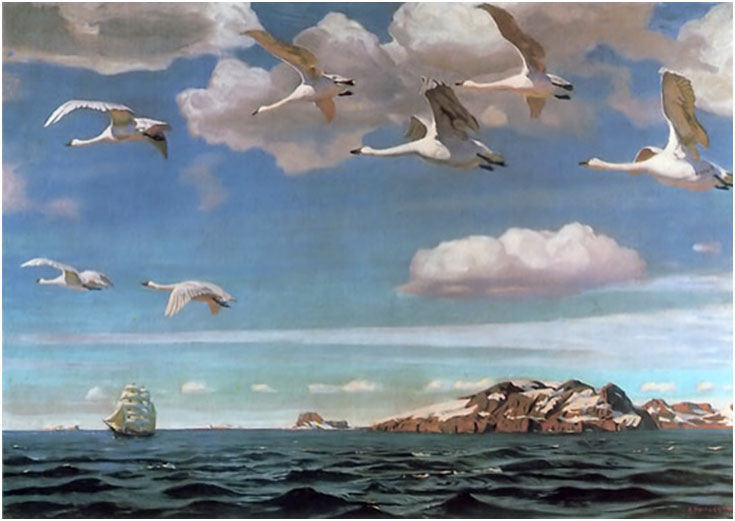
Blue Expanse. 1918, oil on canvas, 109 × 152 cm. The State Tretyakov Gallery, Moscow, Russia.
• Pyotr Konchalovsky (1876–1956)
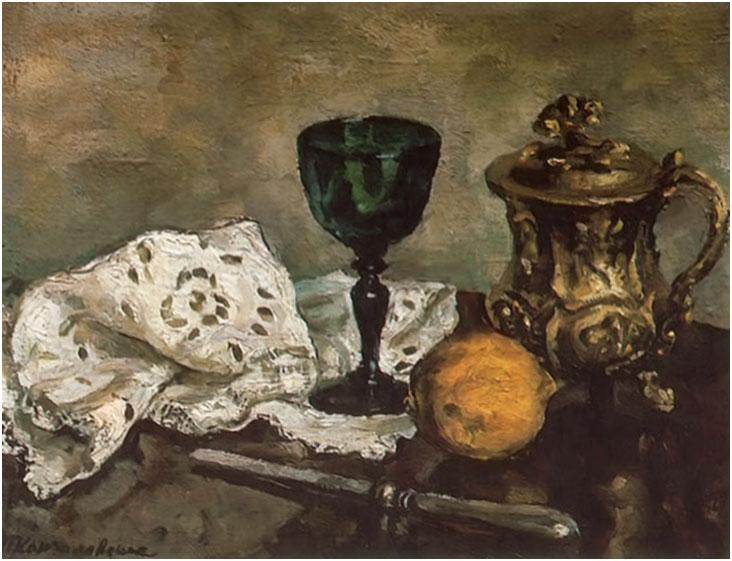
A Green Wineglass. 1933, oil on canvas, 36 × 47cm. The State Tretyakov Gallery, Moscow, Russia.
• Boris Kustodiev (1878–1927)
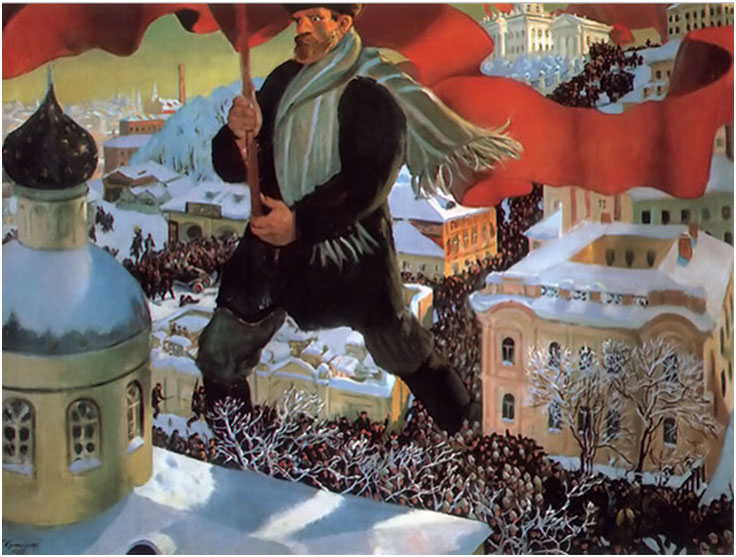
The Bolshevik. 1920, oil on canvas, 101 × 141cm. The State Tretyakov Gallery, Moscow, Russia.
• Kuzma Petrov-Vodkin (1878–1939)
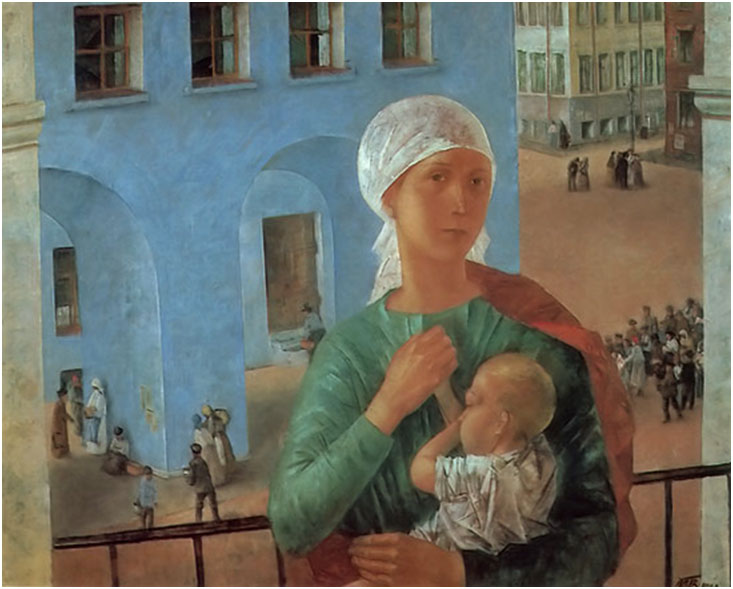
The Year of 1918 in Petrograd. 1920, oil on canvas, 73 × 92cm. The State Tretyakov Gallery, Moscow, Russia.
• Alexander Gerasimov (1881–1963)
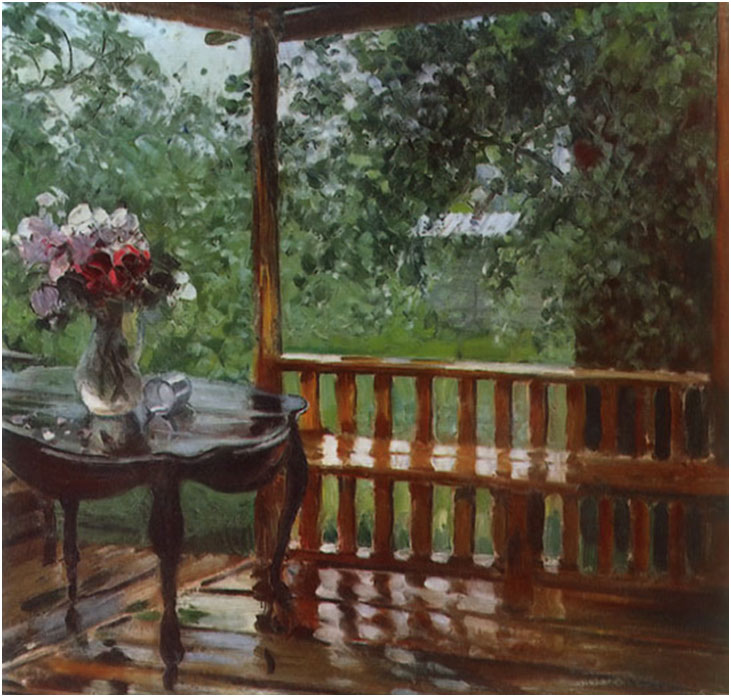
After Rain. A Wet Veranda. 1935, oil on canvas, 78 × 85cm. The State Tretyakov Gallery, Moscow, Russia.
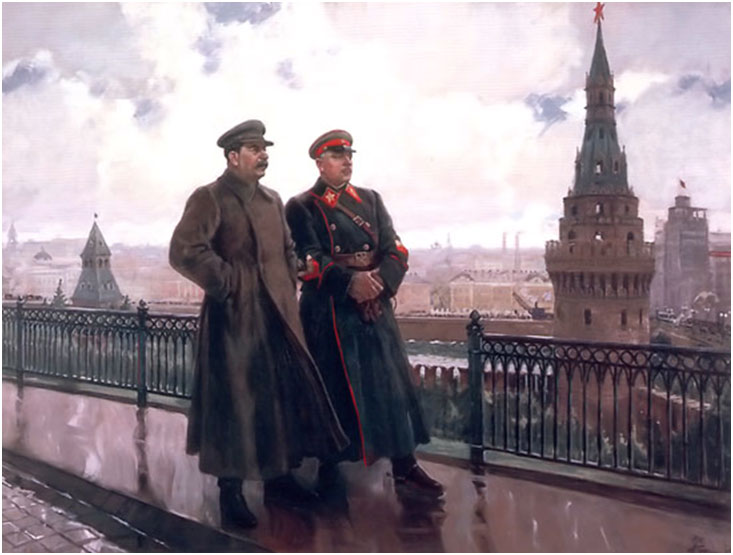
Stalin and Voroshilov in the Kremlin. 1938, oil on canvas, 150 × 195cm. The State Tretyakov Gallery, Moscow, Russia.
• Sergei Gerasimov (1885–1964)
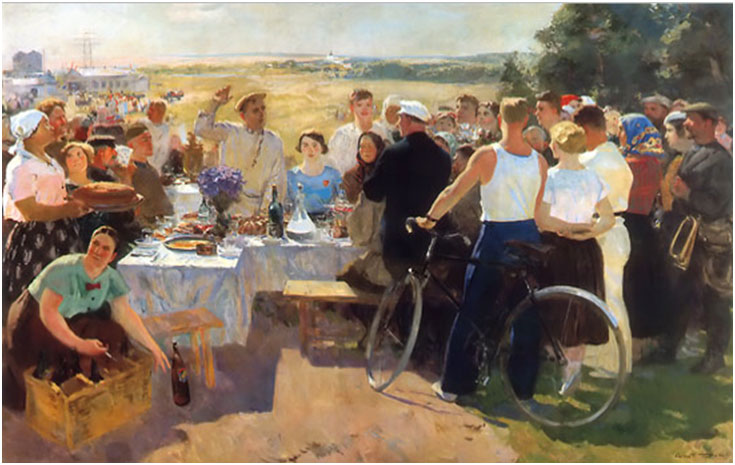
A Kolkhoz Celebration. 1937, oil on canvas, 234 × 372cm. The State Tretyakov Gallery, Moscow, Russia.
• Arkady Plastov (1893–1972)
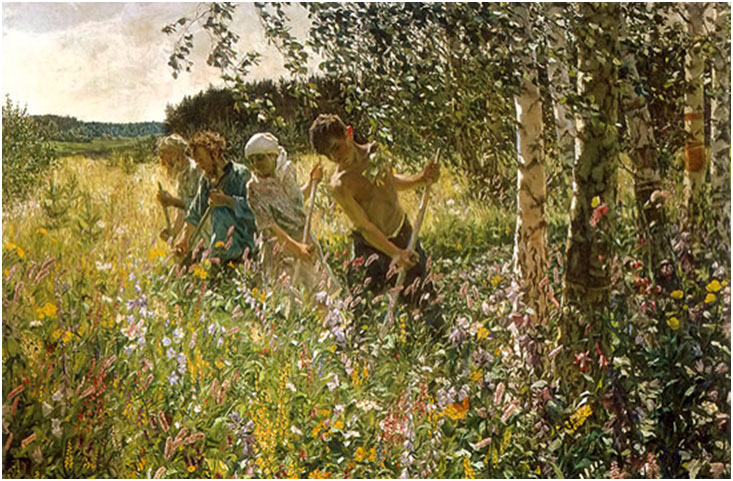
Haymaking. 1945, oil on canvas, 193 × 232cm. The State Tretyakov Gallery, Moscow, Russia.
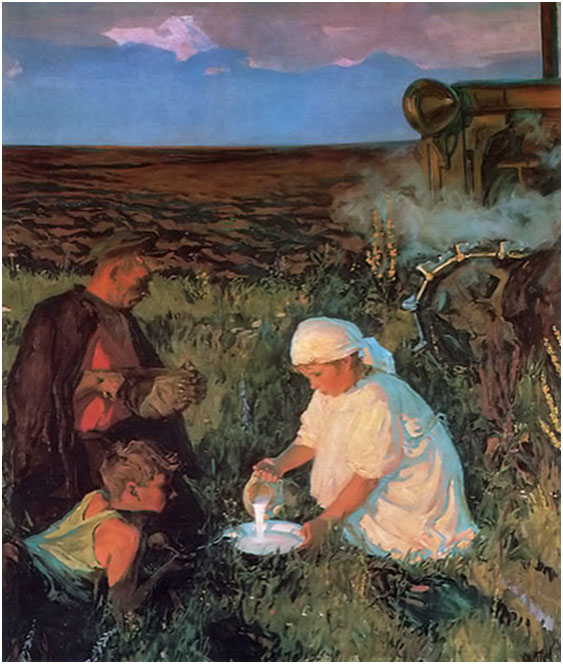
Tractor Driver’s Supper. 1961, oil on canvas, 120 × 194cm. The State Tretyakov Gallery, Moscow, Russia.
• Semyon Chuikov (1902–1980)
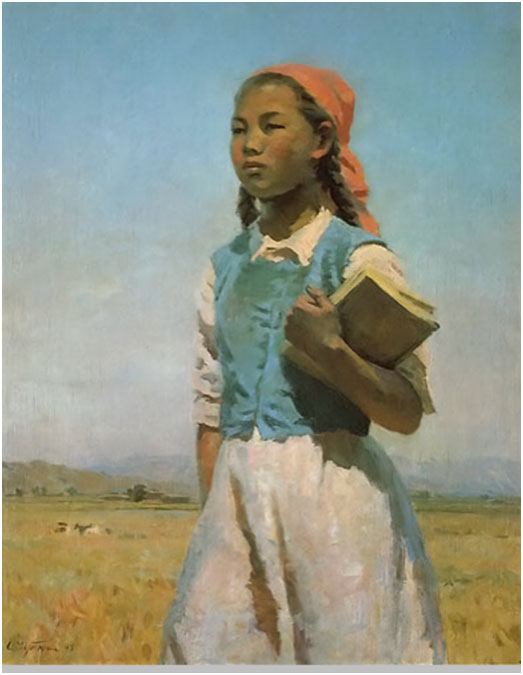
The Daughter of Soviet Kyrgyzia. 1948, oil on canvas, 120 × 95cm. The State Tretyakov Gallery, Moscow, Russia.
• Yuri Pimenov (1903–1977)
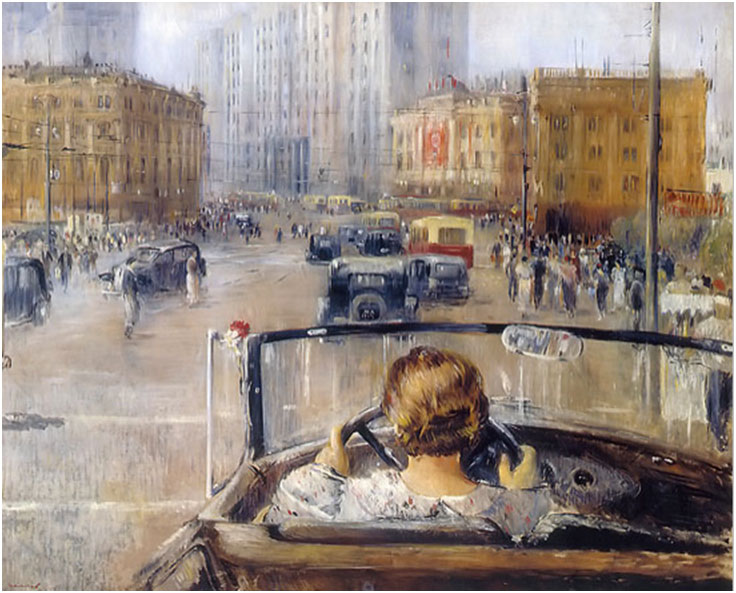
New Moscow. 1937, oil on canvas, 140 × 170cm. The State Tretyakov Gallery, Moscow, Russia.
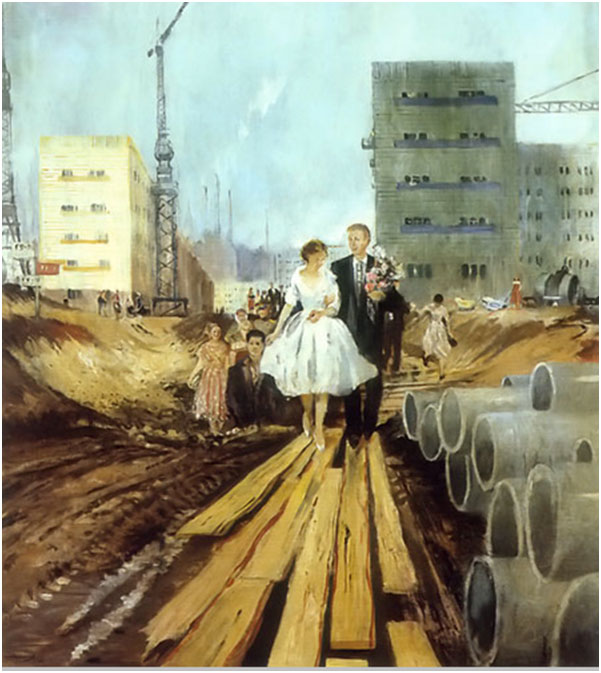
Wedding In a Tomorrow’s Street. 1962, oil on canvas, 86 × 80cm. The State Tretyakov Gallery, Moscow, Russia.
• Georgy Nissky (1903–1987)
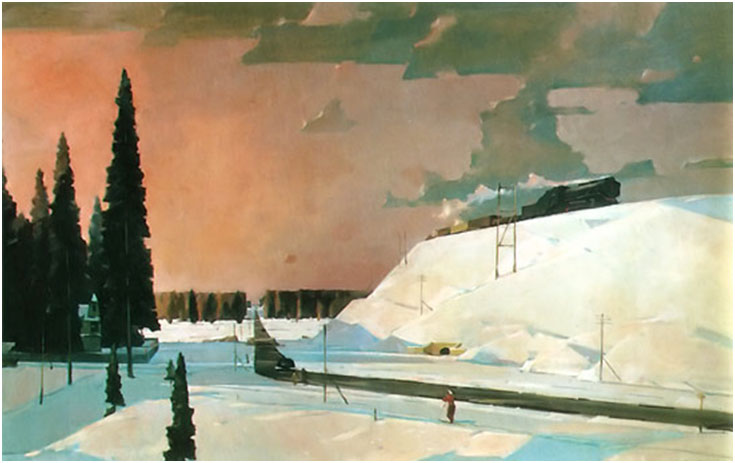
In the Moscow Suburbs. February. 1957, oil on canvas, 120 × 194cm. The State Tretyakov Gallery, Moscow, Russia.
• Yuri Neprintsev (b. 1909)
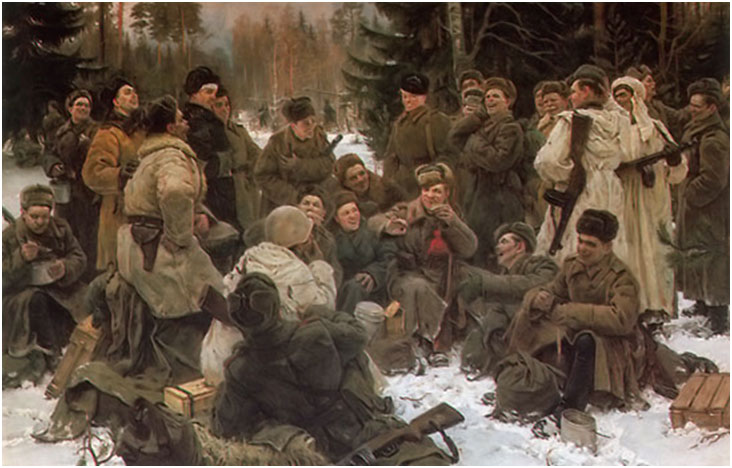
Rest After Battle. 1955, oil on canvas, 192 × 300cm. The State Tretyakov Gallery, Moscow, Russia.
• Sergei and Alexei Tkachev (b. 1922 and 1925)
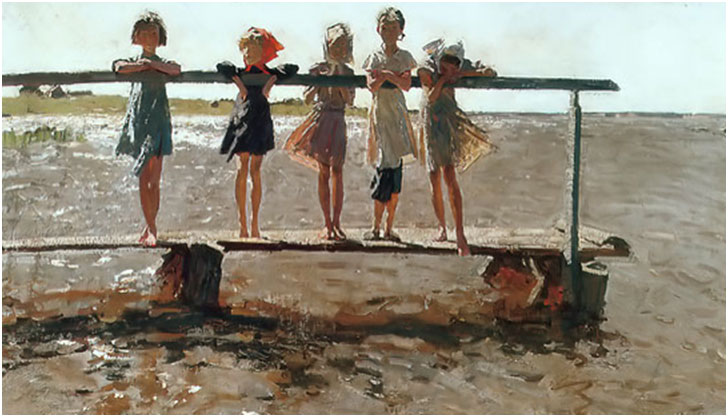
Children. 1960, oil on canvas, 121 × 200cm. The State Russian Museum, St. Petersburg, Russia.
• Vladimir Gavrilov (1923–1970)
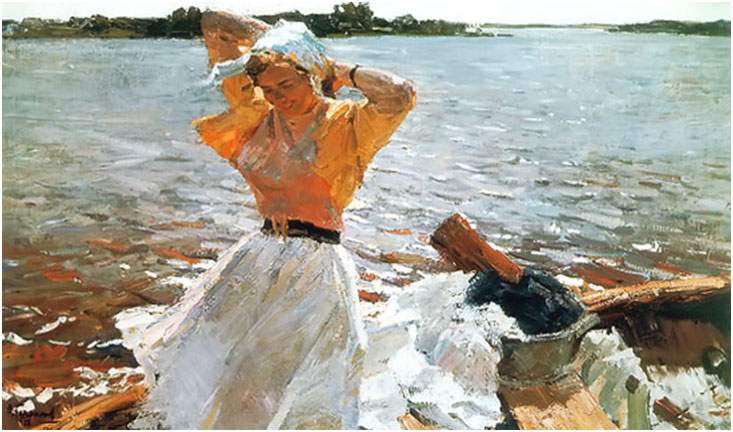
Windy Day. 1958, oil on canvas, 98 × 173cm. The State Tretyakov Gallery, Moscow, Russia.

Young Mothers. 1970, oil on canvas, 215 × 125cm. The State Tretyakov Gallery, Moscow, Russia.
• Vladimir Stozharov (1926–1973)
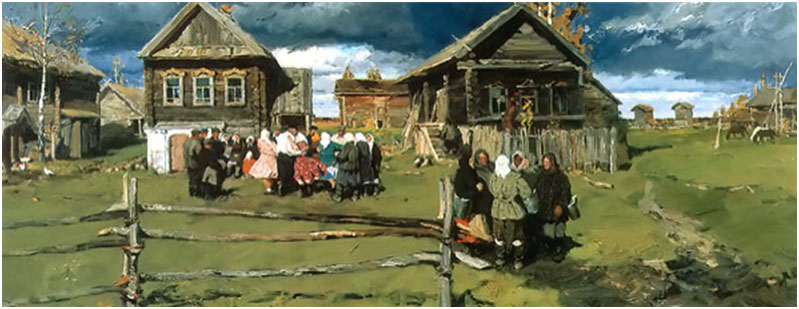
The Village of Andreikovo. 1958, oil on canvas, 80 × 200cm. The State Tretyakov Gallery, Moscow, Russia.
• Viktor Popkov (1932–1974)
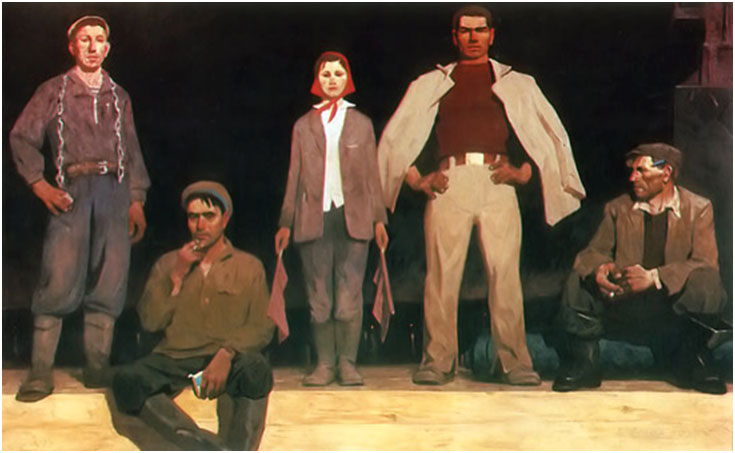
Builders of Bratsk. 1960–61, oil on canvas, 183 × 300cm. The State Tretyakov Gallery, Moscow, Russia.
142,710 total views, 26 views today


 Lindsay Russian Art - Agents and Dealers in Russian Art
Lindsay Russian Art - Agents and Dealers in Russian Art